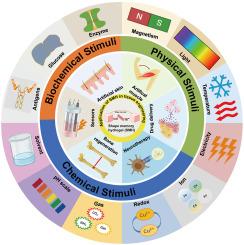组织工程中的形状记忆水凝胶:最新进展和挑战
IF 18
1区 医学
Q1 ENGINEERING, BIOMEDICAL
引用次数: 0
摘要
形状记忆水凝胶(SMHs)由于其在变形后恢复其原始形状的独特能力而成为组织工程中的变革性材料。这些水凝胶结合了亲水性、弹性和形状记忆能力,使其成为各种生物医学应用的理想候选者。本文综述了它们的创新设计和合成,强调了使它们非常适合组织工程的物理和生物学特性,如机械性能、生物相容性和生物降解性。smh在组织工程中有着广泛的应用,包括骨再生、软组织重建、血管和神经组织工程。此外,它们还用于智能药物输送系统和3d打印定制植入物的制造。尽管取得了这些进步,但诸如生产可扩展性、机械性能优化、形状恢复和固定、可控降解和长期稳定性等挑战仍然存在。跨学科方法对于克服这些挑战和增强其临床潜力至关重要。总之,smh为复杂的生物医学问题提供了创新的解决方案,使其成为推进再生医学和改善患者预后的宝贵工具。本文章由计算机程序翻译,如有差异,请以英文原文为准。

Shape memory hydrogels in tissue engineering: Recent advances and challenges
Shape memory hydrogels (SMHs) have emerged as transformative materials in tissue engineering, owing to their unique ability to recover their original shape after deformation. These hydrogels combine hydrophilicity and elasticity with shape memory capabilities, making them ideal candidates for various biomedical applications. This review examines their innovative design and synthesis, highlighting the physical and biological characteristics that make them well-suited for tissue engineering, such as mechanical properties, biocompatibility, and biodegradability. SMHs have diverse applications in tissue engineering, including bone regeneration, soft tissue reconstruction, and the engineering of vascular and neural tissues. Additionally, they are utilized in smart drug delivery systems and the fabrication of 3D-printed customized implants. Despite these advancements, challenges such as production scalability, optimization of mechanical properties, shape recovery and fixation, controlled degradation, and long-term stability persist. Interdisciplinary approaches are crucial for overcoming these challenges and enhancing their clinical potential. In conclusion, SMHs offer innovative solutions to complex biomedical problems, making them valuable tools for advancing regenerative medicine and improving patient outcomes.
求助全文
通过发布文献求助,成功后即可免费获取论文全文。
去求助
来源期刊

Bioactive Materials
Biochemistry, Genetics and Molecular Biology-Biotechnology
CiteScore
28.00
自引率
6.30%
发文量
436
审稿时长
20 days
期刊介绍:
Bioactive Materials is a peer-reviewed research publication that focuses on advancements in bioactive materials. The journal accepts research papers, reviews, and rapid communications in the field of next-generation biomaterials that interact with cells, tissues, and organs in various living organisms.
The primary goal of Bioactive Materials is to promote the science and engineering of biomaterials that exhibit adaptiveness to the biological environment. These materials are specifically designed to stimulate or direct appropriate cell and tissue responses or regulate interactions with microorganisms.
The journal covers a wide range of bioactive materials, including those that are engineered or designed in terms of their physical form (e.g. particulate, fiber), topology (e.g. porosity, surface roughness), or dimensions (ranging from macro to nano-scales). Contributions are sought from the following categories of bioactive materials:
Bioactive metals and alloys
Bioactive inorganics: ceramics, glasses, and carbon-based materials
Bioactive polymers and gels
Bioactive materials derived from natural sources
Bioactive composites
These materials find applications in human and veterinary medicine, such as implants, tissue engineering scaffolds, cell/drug/gene carriers, as well as imaging and sensing devices.
 求助内容:
求助内容: 应助结果提醒方式:
应助结果提醒方式:


